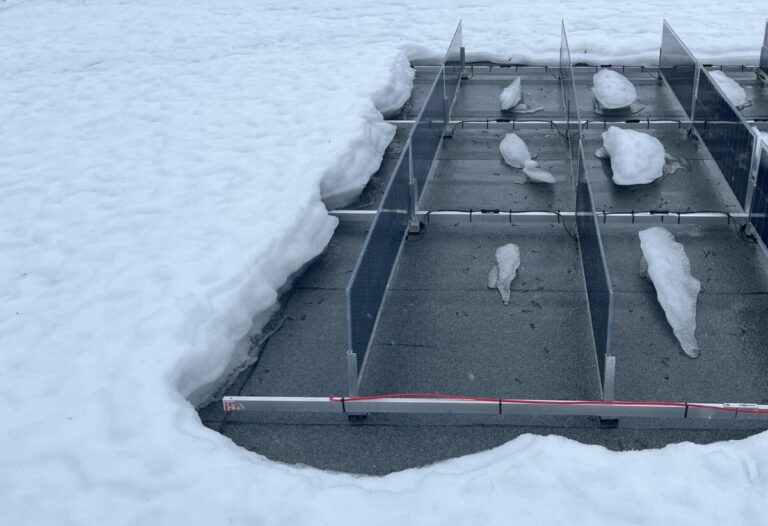A case study analysis from Norway’s Over Easy Solar found that vertical rooftop solar panels outperform conventional rooftop PV systems during the snowy months. According to the company, energy yields in Norway were up to 30% higher in the winter months.
Vertical rooftop solar panels perform better than conventional systems during the snowy months, Norway’s Over Easy Solar has discovered. The company, which produces vertical PV units, said it conducted a case study study in Oslo and found the output of the vertical panels remained consistent into early spring, even after fresh snowfall.
“Our data shows that the annual energy yield of vertical solar panels can be the same or up to 30% higher than that of conventional flat roof solar installations,” said company founder and CEO Trygve Mongstad. pv magazine. “During the winter months in Norway, three to four times more energy is generated for vertical solar panels than for conventional solar installation on flat roofs.”
The company explained that vertical panels perform better under low snow cover of up to 10 cm and under partial snow cover of up to 30 cm. When there is little snow, they benefit from an increased albedo due to the snow; with partial snow cover, panels continue to capture sunlight as they protrude from the snow.
“The portion covered in snow will not produce anything, but the way Over Easy Solar solar panels are designed, partial snow coverage will not significantly impact how the uncovered portion of the solar panel produces,” the company said. “However, vertical solar panels that are completely covered in snow will not produce electricity, just like conventional tilted solar panels.”
According to the company, another advantage of vertical panels in snowy conditions is that the snow around them melts faster. That’s because the orientation of the panel promotes the mixing of warmer air with the snow-covered surface. In addition, they say, the vertical panels trap heat when the sun shines, speeding the thawing of adjacent snow.
“Additionally, solar installations with vertical panels are less likely to damage the roof membrane or insulation typically used in cold climates,” Mongstad added. “Our product was developed with the needs of solar installers and building owners in mind after my team and I spent many years working with flat roof solar installations in Norway.”
In August, Over Easy commissioned what it describes as the world’s largest vertical dual-sided rooftop solar installation to date. It was installed in the Norwegian national football stadium.
The 284.4 kW system consists of 1,242 vertical photovoltaic units of 200 W each, supplied by Over Easy itself. Over Easy Solar’s XM-2 Quattro-200S vertical panels feature silicon heterojunction cells and a module architecture that is said to offer 95.7% bifaciality. The panels are also claimed to be lightweight, with a weight gain of less than 11kg/m2.
A 102 kW installation with an area of 1200 m2 was also deployed on a flat-roof commercial building in Oslo.
Over Easy has a new, low, all-in-one system design for flat roofs. The systems are delivered to the installation site in a pre-assembled single unit, including the unconventional heterojunction bifacial modules, mounting rack and cabling.
The company calls its prefabricated product a “vertical photovoltaic (VPV) unit” and each unit is rated at 200 W. They are available in two sizes, one for green roofs, measuring 1,600 mm x 1,500 mm x 345 mm and a weight of 26 kg, and one for roofs without vegetation, dimensions 1,600 mm x 1,500 mm x 265 mm and weight 25 kg. The clearance for both products is 120 mm and 40 mm respectively.
This content is copyrighted and may not be reused. If you would like to collaborate with us and reuse some of our content, please contact: editors@pv-magazine.com.


